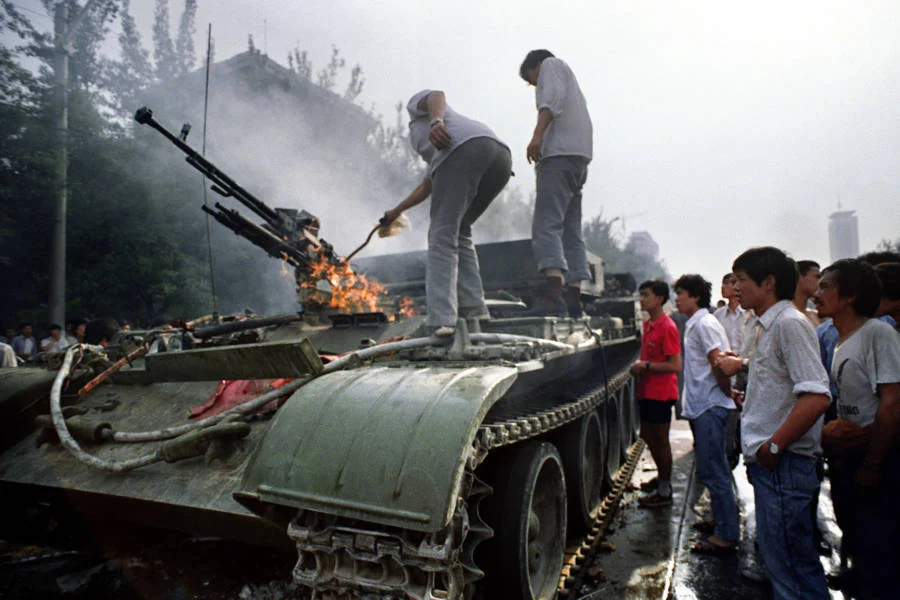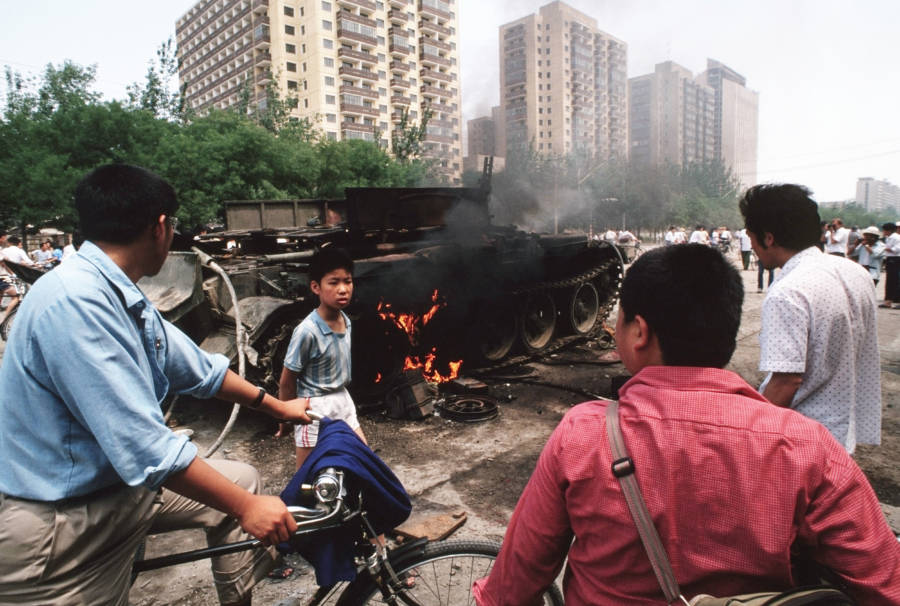In 1989, Tiananmen Square in Beijing became the epicenter of one of the most significant yet largely suppressed events in modern history. The protests that took place in this iconic space would not only change the course of China’s political landscape but would also be erased from the nation’s collective memory. Known as the Tiananmen Square Massacre, the violent crackdown that followed the peaceful student-led protests remains one of the most tragic and censored chapters in the history of the Chinese Communist Party (CCP). The truth behind this event has been intentionally obscured, with the true extent of the violence and the number of lives lost hidden from the world for decades. This is the story of a massacre that has been denied, and the ongoing fight to uncover the truth.
The Build-Up to the Tiananmen Square Protests
The seeds of the 1989 Tiananmen Square protests were sown in the political turmoil that followed the death of Hu Yaobang, a former CCP General Secretary. Hu had been known for his reformist views and his efforts to push for political liberalization. When Hu passed away in April 1989, students across China gathered to mourn, and their grief quickly evolved into calls for greater political freedom, democracy, and an end to corruption within the Party. These initial gatherings, especially in Tiananmen Square, grew into massive protests, with students and citizens demanding greater freedom of speech, improved human rights, and an end to censorship.
The socio-political climate in China in the late 1980s was a turbulent one. The country was undergoing rapid economic reforms, but there was also significant dissatisfaction with the lack of political openness and the gap between the government’s promises and the reality on the ground. The protests were not just about democracy but also about the hope for a brighter, more transparent future.
The Rise of the Protests and the Role of Media

As the protests continued to grow, they caught the attention of the media. Initially, the Chinese government allowed limited coverage of the events, but as the demonstrations spread to other cities, the Party began to view the protests as a threat to their authority. The media, particularly international outlets, played a crucial role in bringing the story of the protests to the global stage, leading to international support for the students. The iconic image of the “Goddess of Democracy,” a student-created statue that stood proudly in Tiananmen Square, became a symbol of the hopes of the protesters.

Despite this, the Chinese government remained adamant that these protests would not undermine their control. On the night of June 3, 1989, martial law was declared, and troops were deployed in Beijing, signaling the beginning of a violent military crackdown that would leave the protesters and the world shocked.
Video
Watch the documentary “How the Chinese Communist Party’s Tiananmen massacre crushed democracy in China” by Four Corners to gain insights into the events surrounding the Tiananmen Square massacre.
The CCP’s Response: From Negotiation to Martial Law

Internally, the Chinese Communist Party was divided on how to handle the protests. Some leaders advocated for dialogue and peaceful resolution, while others, led by hardliners, pushed for an outright military response. Ultimately, the decision was made to deploy the army to suppress the protests. On June 4, 1989, soldiers and tanks rolled into Tiananmen Square, and the scene turned into a warzone, as the military opened fire on unarmed civilians.
At the time, the CCP claimed that the military intervention was necessary to restore order. However, the brutality of the crackdown contradicted these claims. The protests, which had been peaceful for weeks, quickly turned violent as the military surrounded the square, trapping thousands of students and civilians. Tanks rolled over barricades, and troops indiscriminately shot protesters and bystanders alike.
June 4, 1989: The Massacre Unfolds

The morning of June 4, 1989, witnessed one of the most harrowing episodes in Chinese history. Troops moved in from all sides, surrounding Tiananmen Square and cutting off all escape routes. The violent use of force by the Chinese military left many dead and injured. While official figures estimated only a few hundred casualties, various independent reports, including testimonies from survivors and declassified documents, suggest that the true death toll was much higher. Some estimates put the number of deaths in the thousands.
One of the most iconic and heartbreaking moments from the massacre was the image of “Tank Man,” a lone protester who stood in front of a column of tanks, blocking their path. This image became a symbol of courage and defiance, representing the individual’s stand against an oppressive regime. Despite being filmed and photographed, the identity and fate of Tank Man remain a mystery, adding to the tragedy of June 4th.
The Hidden Death Toll: Declassified Information
The true extent of the massacre remained hidden for years. In the aftermath of the crackdown, the Chinese government controlled the narrative, censoring news outlets and detaining those who attempted to speak out about the events. The Party’s narrative downplayed the brutality of the military intervention, insisting that the crackdown was necessary to restore order and stability. However, new information, including declassified documents and eyewitness testimonies, has revealed the real scale of the tragedy.
According to various estimates, the death toll could have reached thousands, far exceeding the official reports. Independent investigations and testimony from survivors continue to shed light on the true horror that unfolded that day.
The Chinese Government’s Efforts to Suppress Information

Since the massacre, the Chinese government has worked tirelessly to suppress information about the events of June 4th, 1989. Censorship of both domestic and international media has remained a key tool in ensuring that the massacre remains out of public discourse within China. Anyone who attempts to discuss or commemorate the Tiananmen Square Massacre within China faces arrest or imprisonment. Even today, the mere mention of the massacre is often censored on the internet, with online discussions quickly erased and keywords blocked.
Despite these efforts, the memory of Tiananmen Square has been kept alive through the work of human rights organizations, international media, and the persistence of those who survived the events. The government’s attempts to erase the tragedy have only heightened the desire of many to uncover the truth.


Personal Accounts and Eyewitness Testimonies

First-hand accounts of those who were present at Tiananmen Square offer some of the most harrowing and insightful perspectives on what transpired that fateful day. Many of these testimonies have come from survivors who managed to escape the square or from others who witnessed the events from the outside. These accounts describe the brutality of the military, the desperation of the protesters, and the fear that gripped the city in the days following the massacre.
Gallery: A Visual Tribute to Tiananmen Square
The following images capture the essence of the Tiananmen Square protests and massacre, offering a poignant reminder of the courage, the devastation, and the fight for freedom that transpired on June 4, 1989. These powerful photographs continue to tell the story of a brutal crackdown, the resilience of the protesters, and the ongoing struggle for truth and justice.



































Legacy of the Tiananmen Square Massacre

The Tiananmen Square Massacre has had a lasting impact on Chinese politics and the way the government handles dissent. The massacre not only led to increased repression in the following years but also symbolized the extent to which the government was willing to go to maintain control. The massacre also prompted a reevaluation of China’s relationship with the rest of the world, as the international community watched in horror as the Chinese military cracked down on its own people.
Ongoing Censorship and the Fight for Truth

Despite the Chinese government’s efforts to suppress the memory of Tiananmen Square, the massacre continues to be a focal point for human rights organizations around the world. The struggle to ensure that the truth about June 4, 1989, is known remains an ongoing battle. Activists, both within China and abroad, continue to push for the Chinese government to acknowledge the events and take responsibility for the atrocities committed that day.
Video
Watch the BBC News video “Tiananmen Square: What Happened in the 1989 Protests?” to learn about this pivotal moment in history.
Conclusion: Remembering the Tiananmen Square Massacre
The Tiananmen Square Massacre, one of the darkest moments in modern history, serves as a reminder of the cost of political repression. While the Chinese government has worked hard to erase the event from collective memory, the truth continues to surface, thanks to the persistence of those who lived through it and the international community’s efforts to bring the truth to light. As long as there are people willing to speak out and remember, the Tiananmen Square Massacre will never be forgotten.



